The United Kingdom is home to various birds, from the small, colorful robins to the majestic owls and eagles. These birds can be seen in gardens, parks, lakes, rivers, and woods, and even in man-made habitats such as rooftops and buildings.
The UK is a great place to observe and study birds, as many species live in the country, many of which are unique to the region. From the great tits that chirp in the morning to the flocks of swans that migrate across the country, the UK’s birds are an integral part of its rich and diverse wildlife.
51 Birds Of United Kingdom
The United Kingdom is a wonderful place to enjoy the beauty and diversity of birds. Whether a beginner or an expert, you can find many species to admire and learn about in different habitats and seasons.
We will introduce you to 51 birds of the United Kingdom that you should know.
1. House Sparrow
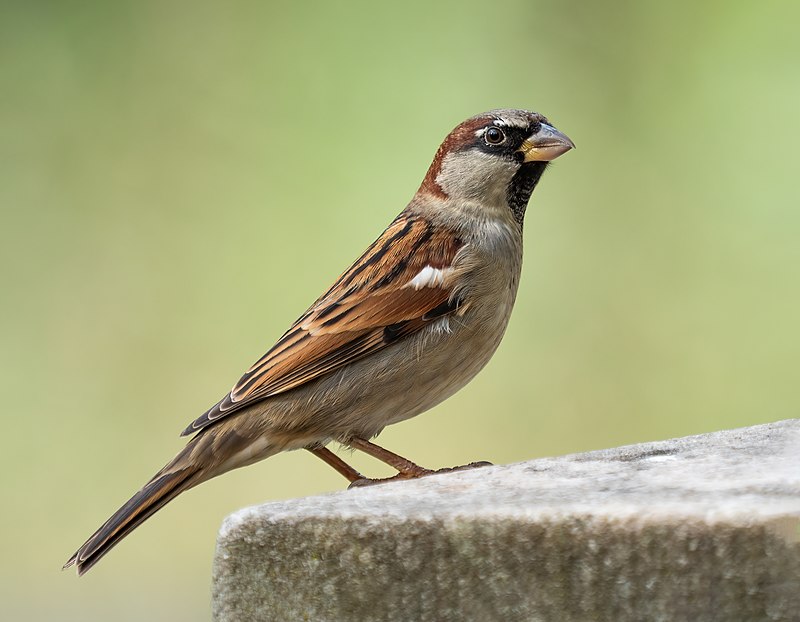
The house sparrow is a small bird of the Passeridae family. It has an average length of 16 cm and weighs 24-39.5 gm.
Females have dull brown and grey plumage, whereas males are brighter, with black, white, and brown markings on their wings and back feathers.
This species is one among 25 different kinds in its genus Passer. These birds are found worldwide, mainly near human dwellings where they feed off food scraps from garbage bins or gardens.
They also make nests close to houses, making them even more visible to nearby people.
House sparrows can be seen hopping around yards for food during daytime hours but usually hide in colonies at night.
Scientific classification:
| Kingdom | Animalia |
| Phylum | Chordata |
| Class | Aves |
| Order | Passeriformes |
| Family | Passeridae |
| Genus | Passer |
| Species | P. domesticus |
2. Common Blackbird
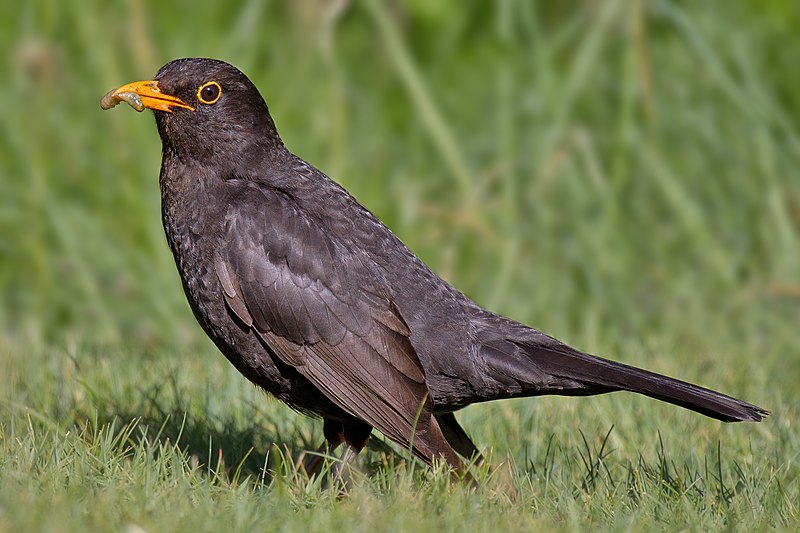
The Common Blackbird is a species of true thrush with the scientific name Turdus merula. Found in Europe, Asiatic Russia and North Africa it has also been introduced to Australia and New Zealand.
The male bird has glossy black plumage, while the female’s coloration is more brownish gray.
It is known for its melodious song that can be heard throughout the year; typically, they are seen alone or in pairs but occasionally form large flocks when food sources become available or during migration periods.
Its diet consists mainly of insects, worms, berries and other fruits as well as some human-provided foods such as bread crumbs or garbage scraps when available.
With its wide distribution range and ease of adaptation to different habitats, this species will likely remain among our most common birds.
Scientific classification:
| Kingdom | Animalia |
| Phylum | Chordata |
| Class | Aves |
| Order | Passeriformes |
| Family | Turdidae |
| Genus | Turdus |
| Species | T. merula |
Also Featured In: Birds for Your Home Garden, Most Common Songs Birds that Live around You
3. Eurasian Blue Tit
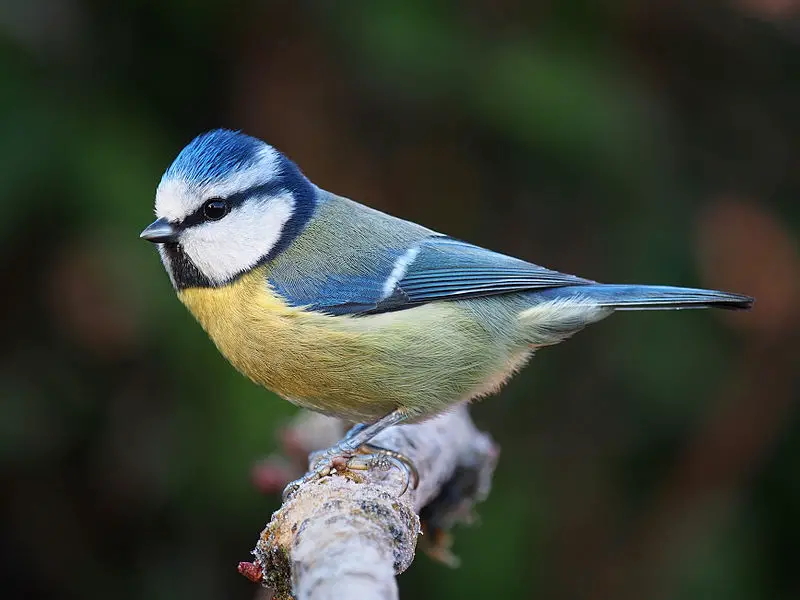
The Eurasian blue tit is a small passerine bird belonging to the Paridae family. Its bright blue and yellow plumage makes it easily recognizable, along with its small size.
They are usually resident birds that do not migrate, living throughout temperate or subarctic Europe and the western Palearctic in deciduous woodlands.
These birds breed year-round and are common residents of these areas.
Their diet consists mainly of insects, but they feed on seeds during winter when insects become scarce.
They can be found alone or in pairs, searching for food amongst trees, branches, shrubs, and grasses and visiting gardens for supplementary food sources such as peanut feeders provided by garden owners.
Scientific classification:
| Kingdom | Animalia |
| Phylum | Chordata |
| Class | Aves |
| Order | Passeriformes |
| Family | Paridae |
| Genus | Cyanistes |
| Species | C. caeruleus |
Also Featured In: Famous Paintings Birds, Italian Birds You Should Know
4. Long-Tailed Tit
The Long-tailed tit is a common bird found throughout Europe and the Palearctic. Described by Carl Linnaeus in 1758, it has been given the scientific name Aegithalos caudatus, which translates to “long-tailed bush-tit”.
These birds are small with white bellies and grey backs. The distinguishing feature of this species is its long tail feathers, which give them their name.
They feed on insects such as moths, flies, and spiders and eat seeds from plants like thistles or dandelions.
In cold weather, they flock together for warmth, while at night, they roost inside woodpecker holes or other crevices in trees.
Long-tailed tits build intricately woven nests made of mosses, lichens, spider webs, and fur held together by saliva – these can be up to 15 cm wide.
Scientific classification:
| Kingdom | Animalia |
| Phylum | Chordata |
| Class | Aves |
| Order | Passeriformes |
| Family | Aegithalidae |
| Genus | Aegithalos |
| Species | A. caudatus |
Also Featured In: Ukrainian Birds You Should Know, Mountain Birds You Should Know
5. European Robin
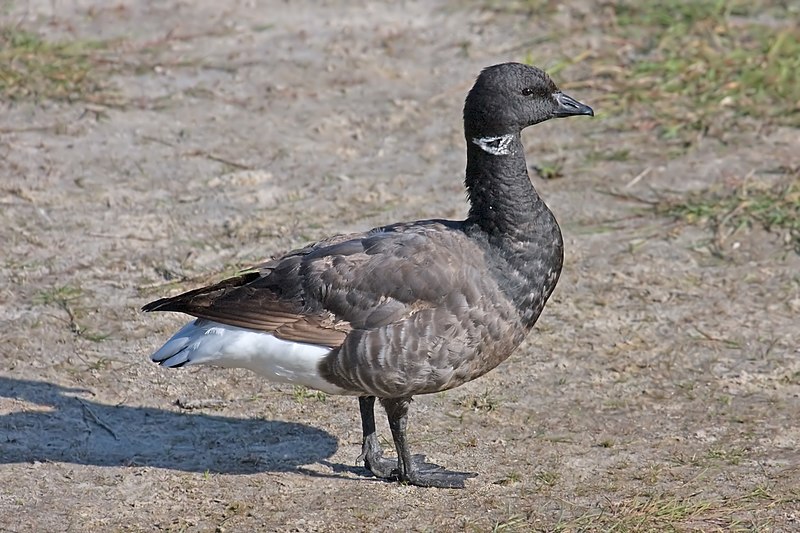
The European robin is a small passerine bird native to Europe, North Africa, and western Asia. It has an orange-red breast and face with grey upperparts.
Its distinctive red coloring makes it one of Europe’s most popular garden birds. Robins can live throughout much of Eurasia in woods, hedgerows, parks, gardens, and scrubland habitats such as heaths or moorlands.
They feed mainly on insects but also eat worms, fruit flies, and other invertebrates they find while foraging around woodland floor vegetation or perching from low branches to catch their prey in flight.
They are highly territorial during the breeding season, which runs from March through August when both males & females stand guard over their territories using song communication to mark boundaries between each others’ turf.
6. Great Tit
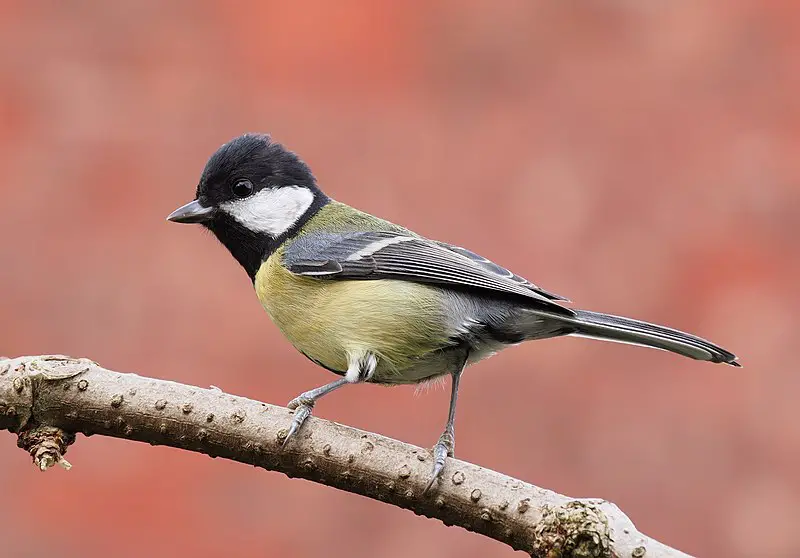
The Great Tit is a small passerine bird found in woodlands throughout Europe, the Middle East, and Central Asia. Its beautiful black and white plumage with bold yellow or green patches makes it easily distinguishable from other species of its family.
It generally does not migrate except for harsh winters but will stay resident in any woodland area.
The diet consists mainly of insects, seeds, and nuts, found by searching through trees or scavenging from feeders placed near gardens.
Great Tits are also known to be clever problem solvers; they can open milk bottles left out unattended as well as cracking sunflower seeds that provide them essential nutrients during winter months when food is scarce.
Scientific classification:
| Kingdom | Animalia |
| Phylum | Chordata |
| Class | Aves |
| Order | Passeriformes |
| Family | Paridae |
| Genus | Parus |
| Species | P. major |
Also Featured In: Birds Found in Hungary, Common Birds in the Cities
7. European Goldfinch
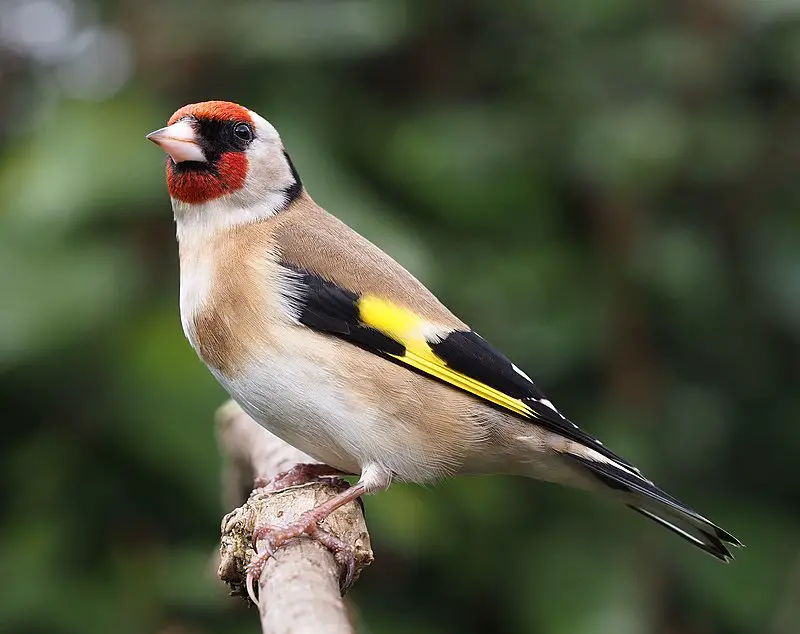
The European Goldfinch is a small passerine bird belonging to the finch family. It inhabits Europe, North Africa, western and central Asia but has been introduced in other places such as Australia, New Zealand and Uruguay.
Its red face can easily identify the breeding male of this species with black markings around the eyes and black-and-white head.
Its back and flanks are buff or yellowish, while it has white underparts, which contrast well with its dark wings edged in white feathers.
This bird feeds on grains from plants like millet or sunflower seeds along with insects occasionally when available during summer months for food source.
In winter they flock together near sources of water where they find their food among weeds growing there at that time of year.
Scientific classification:
| Kingdom | Animalia |
| Phylum | Chordata |
| Class | Aves |
| Order | Passeriformes |
| Family | Fringillidae |
| Subfamily | Carduelinae |
| Genus | Carduelis |
| Species | C. carduelis |
8. Wrens
Wrens are a family of small brown passerine birds found mainly in the Americas. They are considered one of the most abundant bird species, with 88 known varieties divided into 19 genera.
The Eurasian wren is the only type inhabiting Europe and other parts of the Old World, commonly referred to simply as “wren.”
This species has been given its name due to similar-looking unrelated birds living elsewhere, such as New Zealand wrasses.
Wrens have tiny bodies with thin bills and long tails, which they often hold upright for hours while singing their loud, cheery songs from treetops or low shrubs.
Their diet consists mostly of insects but can also include fruits and seeds depending on availability in their habitat range.
Scientific classification:
| Kingdom | Animalia |
| Phylum | Chordata |
| Class | Aves |
| Order | Passeriformes |
| Superfamily | Certhioidea |
| Family | Troglodytidae Swainson, 1832 |
9. Starling
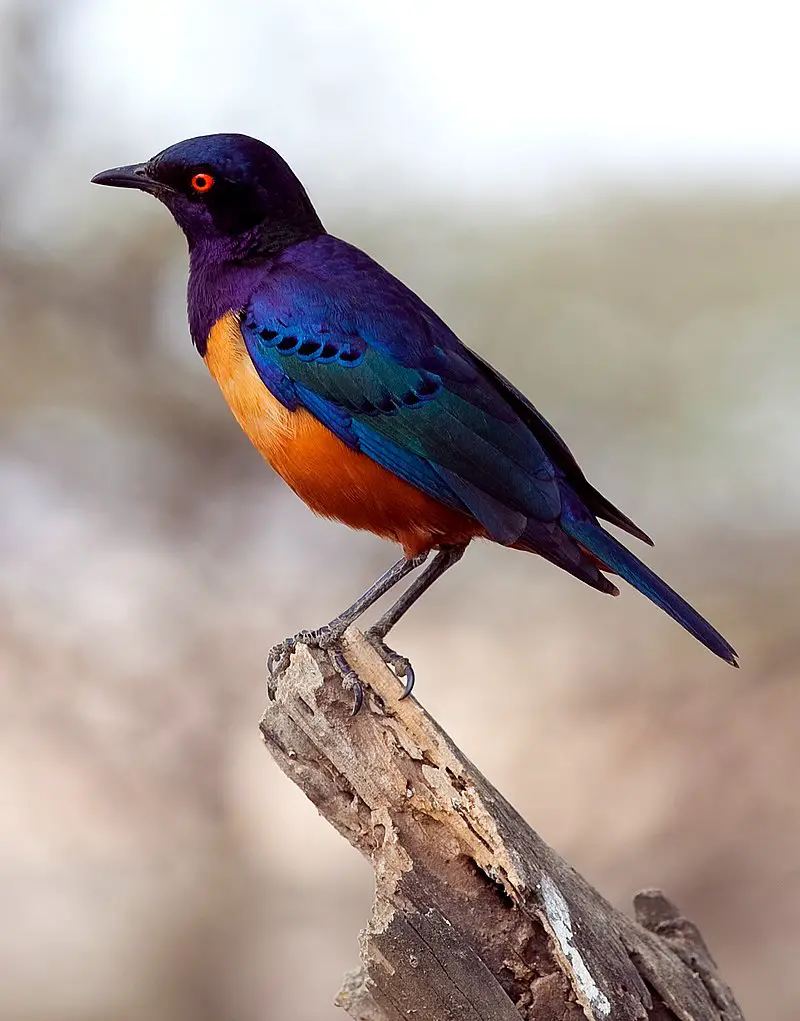
Starlings are small to medium-sized birds belonging to the Sturnidae family. They have unique iridescent plumage, glossy starlings in Africa, and Asian mynas.
Starlings inhabit Europe, Asia, and Africa; some species even migrate between continents for food or better climates.
These birds form large flocks of up to thousands during migration, creating spectacular visual displays while they soar through the sky.
Besides being beautiful creatures, starlings can imitate sounds, such as human speech – an impressive feat documented by many ornithologists.
Scientific classification:
| Kingdom | Animalia |
| Phylum | Chordata |
| Class | Aves |
| Order | Passeriformes |
| Suborder | Passeri |
| Family | Sturnidae Rafinesque, 1815 |
Also Featured In: Most Common Winter Birds, Turkey Birds You Should Know
10. Coal Tit
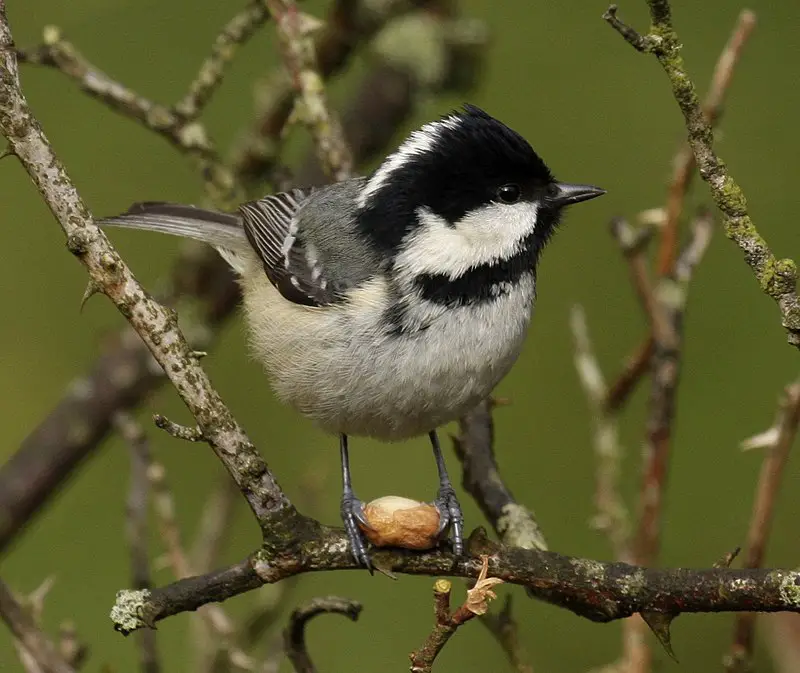
The Coal Tit, also known as the Cole Tit is a small passerine bird belonging to the Paridae family. It has an extensive range, from temperate and subtropical areas in Europe to North Africa.
First described by Carl Linnaeus in Systema Natura back in 1758, it’s now commonly grouped with its cousin – The Black-Crested Tit.
This species thrives best when living near forests or other wooded habitats that provide them with plenty of food sources like insects and seeds.
They are considered quite common throughout their range due to their adaptability and resilience, making them well-suited for urban environments.
Scientific classification:
| Kingdom | Animalia |
| Phylum | Chordata |
| Class | Aves |
| Order | Passeriformes |
| Family | Paridae |
| Genus | Periparus |
| Species | P. ater |
Also Featured In: Autumn Birds You Should Know, Common Birds in London
11. Common Wood Pigeon
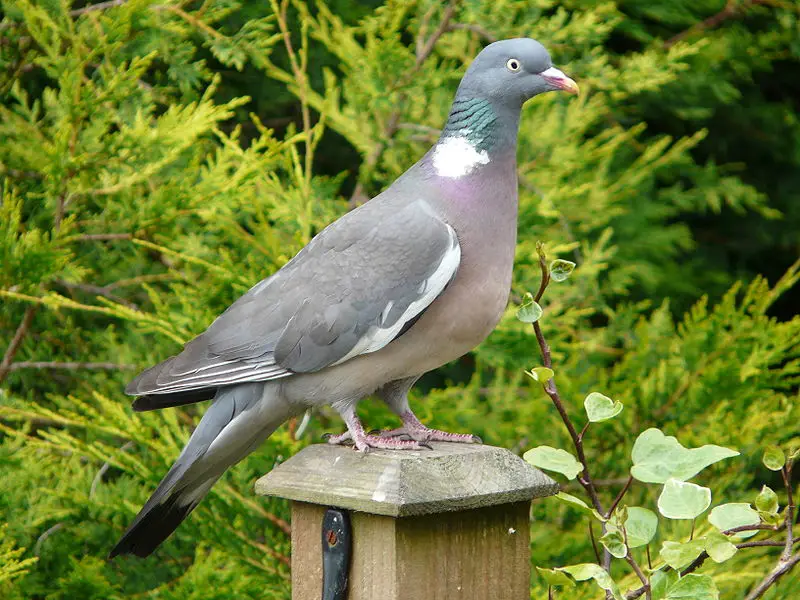
The Common Wood Pigeon is a large bird of the dove and pigeon family, native to the western Palearctic. It has grey plumage with white patches on its wings and neck.
Its head often appears darker than its body due to iridescence in some parts of its feathers. The male woodpigeons have pinkish breasts while females are more brownish-grey coloured.
These birds feed mainly on seeds, fruits, flowers, and leaves but also eat insects when available.
They breed during springtime, producing 1-2 clutches per breeding season with two eggs each time, which hatch after about 18 days incubation period by both parents taking turns for duty.
They make their nests from twigs collected from nearby trees or places and usually raise only one brood at a time, making them an important part of nature’s balance as they help keep insect populations under control through their diet choices.
Scientific classification:
| Kingdom | Animalia |
| Phylum | Chordata |
| Class | Aves |
| Order | Columbiformes |
| Family | Columbidae |
| Genus | Columba |
| Species | C. palumbus |
Also Featured In: Birds of Sweden, Common Serbian Birds
12. Carrion Crow
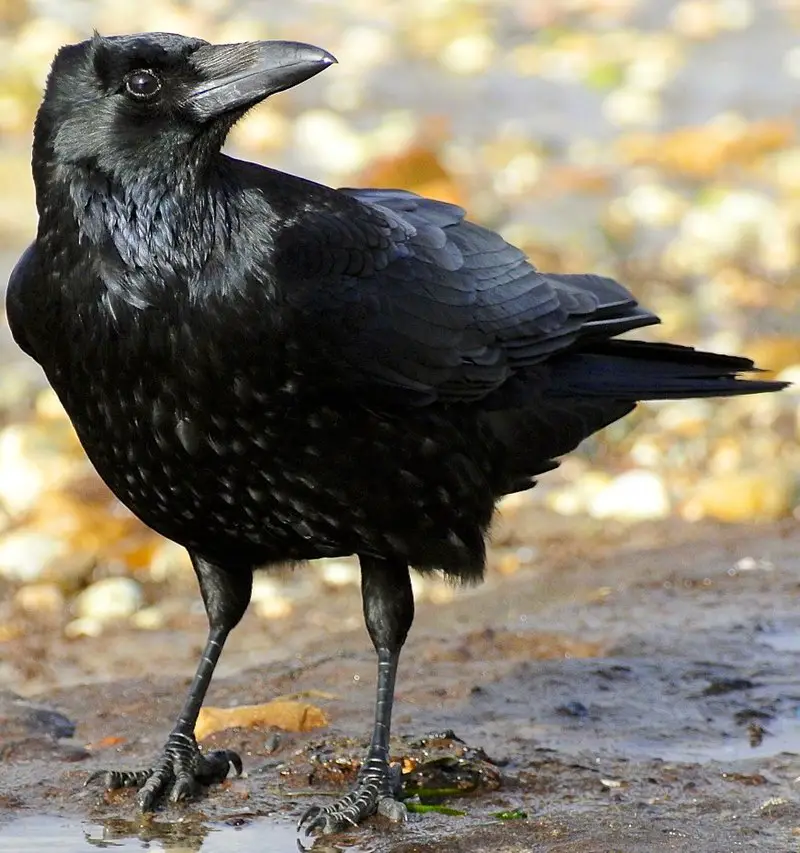
The Carrion Crow is a large, black bird belonging to the Corvidae family and genus Corvus. Native to Western Europe and the Eastern Palearctic, it was one of the species described by Carl Linnaeus in his 1758 10th edition of Systema Naturae.
The name comes from Latin words meaning “crow” and “crown”. This crow has an unmistakable appearance; its entire body is covered in glossy black feathers with blue or purple iridescence on its wings when caught in sunlight.
Its diet consists mainly of carrion, but they also eat insects, fruits, grains, nuts, eggs, and small vertebrates such as young birds.
They are known for their intelligence, which allows them to find food more easily than other corvid species due to their ability to make tools out of sticks or stones, as humans do.
Scientific classification:
| Kingdom | Animalia |
| Phylum | Chordata |
| Class | Aves |
| Order | Passeriformes |
| Family | Corvidae |
| Genus | Corvus |
| Species | C. corone |
Also Featured In: Scavengers Birds You Should Know, Spiritual Birds
13. Dunnock
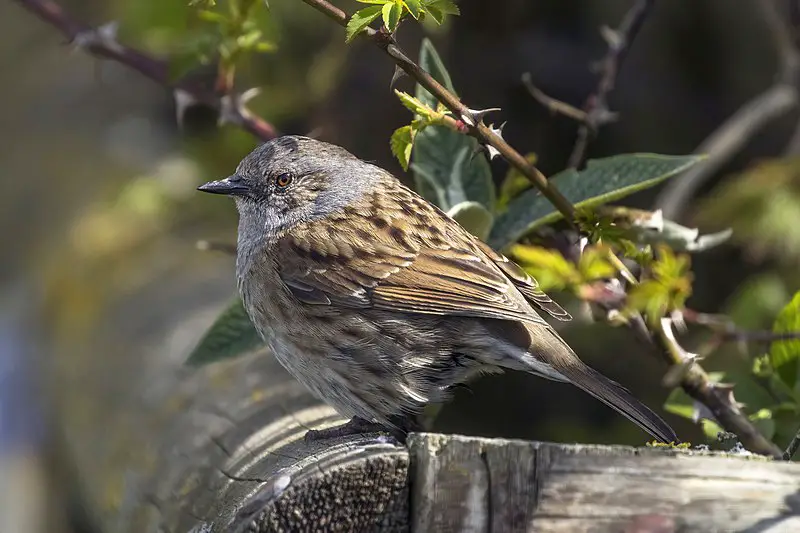
The Dunnock, also known as the Hedge Accentor, Hedge Sparrow and Hedge Warbler, is a small passerine bird found in temperate climates of Europe and Asia.
It has even been successfully introduced to New Zealand. The Dunnock stands out amongst its family members as it can thrive in many habitats beyond mountainous areas – making it more widespread than other birds.
With greyish-brown upperparts and whitish underparts with brown streaks on them, they are easily distinguished from their fellow species by their distinctive saucy call.
Often seen searching for food on the ground or darting around bushes looking for insects and worms; these lively little birds make an attractive addition to any garden or parkland setting.
Scientific classification:
| Kingdom | Animalia |
| Phylum | Chordata |
| Class | Aves |
| Order | Passeriformes |
| Family | Prunellidae |
| Genus | Prunella |
| Species | P. modularis |
Also Featured In: European Birds, Common Birds of Portugal
14. Goldcrest
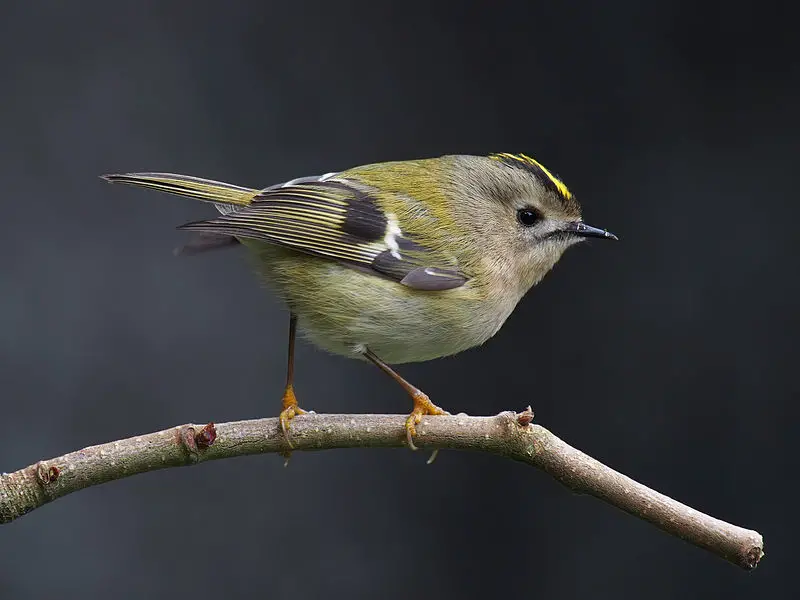
The Goldcrest is a tiny but beautiful bird from the Kinglet family. It has vibrant golden crest feathers, and it’s known as “king of birds” in European folklore.
This regal title is reflected in its scientific name R. Regulus which translates to king or knight.
The goldcrest can be found across Europe, North Africa, and Asia, mainly in coniferous forests where they feed on small insects such as aphids and caterpillars that live on tree bark or foliage.
They also eat spiders, worms, and other invertebrates, making them an important part of their local ecosystem by controlling pest populations while providing food for predators like hawks and owls.
Scientific classification:
| Kingdom | Animalia |
| Phylum | Chordata |
| Class | Aves |
| Order | Passeriformes |
| Family | Regulidae |
| Genus | Regulus |
| Species | R. regulus |
15. Common Chaffinch

The Common Chaffinch is a beautifully coloured small passerine bird belonging to the finch family.
The males have striking blue-grey caps and rust-red underparts, while the females are more subtle in their coloring, but both possess two distinct white wing bars and white sides on their tails.
This gorgeous bird has an incredibly strong voice which can be heard for miles as it sings from exposed perches during mating season.
It lives mainly throughout Europe and parts of North Africa and Asia, favoring woodland areas with plenty of shrubs or trees nearby where they find shelter amongst foliage when needed.
They feed predominantly on seeds from weeds or grains found within grasslands making them particularly useful birds for farmers who rely heavily upon pest control that these little ones provide.
Scientific classification:
| Kingdom | Animalia |
| Phylum | Chordata |
| Class | Aves |
| Order | Passeriformes |
| Family | Fringillidae |
| Subfamily | Fringillinae |
| Genus | Fringilla |
| Species | F. coelebs |
Also Featured In: Birds that Calls in the Morning, Most Common Scotland Birds
16. Eurasian Collared Dove
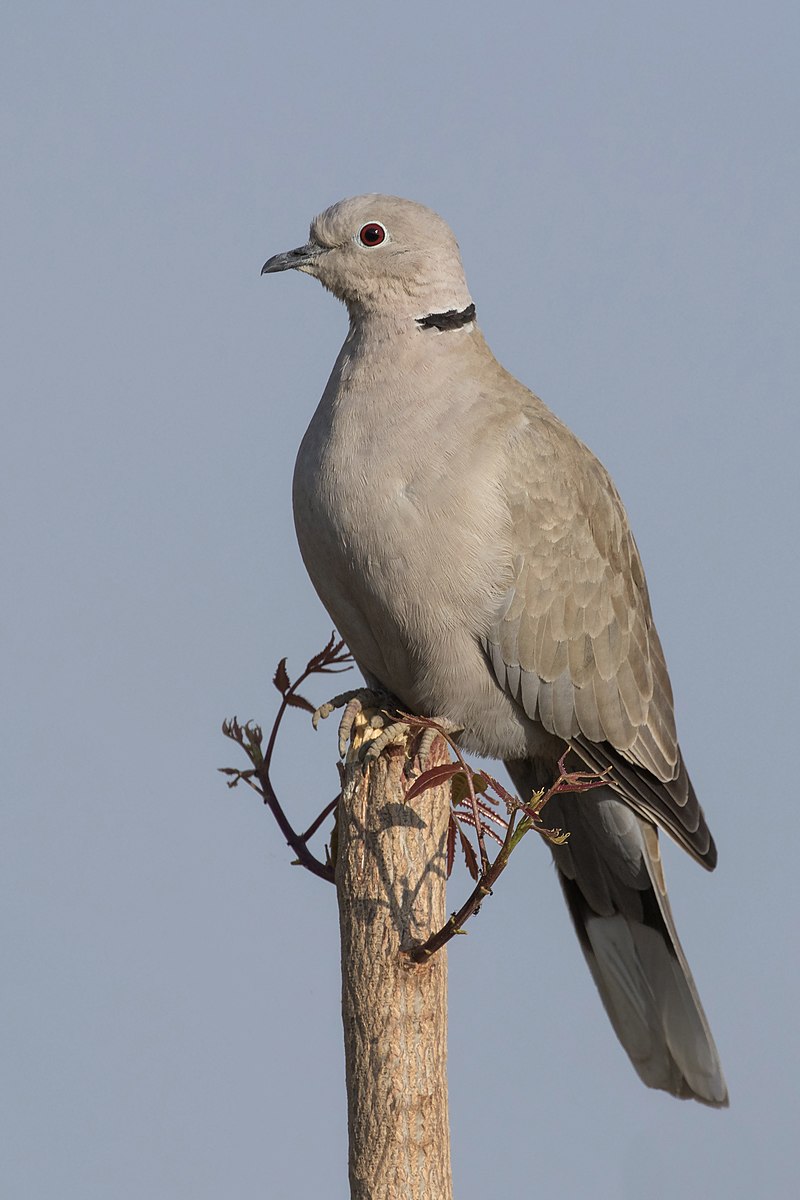
The Eurasian collared dove is a species of bird native to Europe and Asia, with its range expanding through introduction in Japan, North America, and islands in the Caribbean.
It has become so widespread that it is listed as Least Concern on the IUCN Red List. The scientific name for this bird was proposed by Hungarian naturalist Imre Frivaldsz – Columba decaocto.
This beautiful creature typically measures between 33-37 cm from tip to tail feathers, displaying an overall greyish brown plumage; they also have a distinctive black half collar around their neck, which gives them their common name.
These birds are mainly found inhabiting open woodlands or agricultural lands near human settlements where there’s plenty of food available, such as grain fields or gardens where fruits can be eaten off trees.
With a vast global population trend increasing steadily each year these birds make great additions to many backyards throughout the world.
Scientific classification:
| Kingdom | Animalia |
| Phylum | Chordata |
| Class | Aves |
| Order | Columbiformes |
| Family | Columbidae |
| Genus | Streptopelia |
| Species | S. decaocto |
17. Bearded Reedling
The Bearded Reedling is a small passerine bird found in reed-beds across Europe, Asia and North Africa.
It is easily identified by its distinct black and white plumage, with males having yellow faces.
This species belonged to the only family of birds known as Panuridae and was first described by Carl Linnaeus in 1758.
They feed on insects such as beetles, flies, and moths, among others, but also consume seeds from plants like sedges or rushes during winter when food availability decreases significantly.
These birds are territorial, meaning that they have their own area where they live, which can vary from 8 to 12 hectares depending on the seasonality of insect abundance within these areas, making them an important part of maintaining healthy ecosystems in wetlands around their range.
Scientific classification:
| Kingdom | Animalia |
| Phylum | Chordata |
| Class | Aves |
| Order | Passeriformes |
| Family | Panuridae Des Murs, 1860 |
| Genus | Panurus Koch, 1816 |
| Species | P. biarmicus |
Also Featured In: Common Uzbekistan Birds, Most Common Romanian Birds
18. European Greenfinch
The European Greenfinch is a small, passerine bird from the finch family Fringillidae. It can be found throughout Europe, North Africa, and Southwest Asia.
Some of its northernmost populations migrate further south during winter for warmer climates.
The species has been introduced to Australia, New Zealand, Uruguay and Argentina as well with great success in these new environments.
It was first described scientifically by Carl Linnaeus in 1758, who noted its bright green feathers along with yellow edges on the wings and tail, making it an unmistakable sight.
When seen up close or at a distance while flying through open grasslands or wooded areas where they are known to feed on insects and seeds alike making them highly adaptable birds that find food sources easily wherever they go.
Scientific classification:
| Kingdom | Animalia |
| Phylum | Chordata |
| Class | Aves |
| Order | Passeriformes |
| Family | Fringillidae |
| Subfamily | Carduelinae |
| Genus | Chloris |
| Species | C. chloris |
19. Great Spotted Woodpecker
The Great Spotted Woodpecker is a fascinating bird. It has black and white feathers, with red patches on its lower belly and head or neck, depending on whether it’s male or young.
This species inhabits most of the Palearctic region as well as some parts of North Africa.
For much of its range, it remains in one place all year round but may migrate if food sources become limited further north.
Its diet consists mainly of insects found under tree bark along with small amounts of seeds and fruit when available.
Despite being quite vocal, they are hard to spot due to their camouflaged feathers, which help protect them from predators like cats and birds of prey.
Scientific classification:
| Kingdom | Animalia |
| Phylum | Chordata |
| Class | Aves |
| Order | Piciformes |
| Family | Picidae |
| Genus | Dendrocopos |
| Species | D. major |
20. Black-Headed Gull
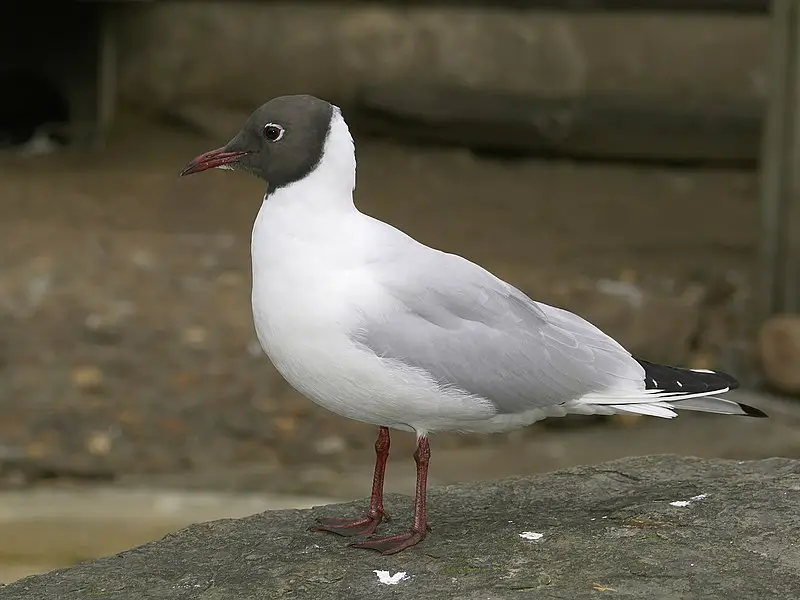
The Black-headed Gull is a small, migratory bird found in much of the Palearctic. It breeds mainly in Europe and coastal eastern Canada but can also be found further west in milder areas.
In North America, it’s known as the Common Black-headed Gull.
Its plumage consists of grey on top with white underneath, while its head has a distinctive black cap during breeding season, which fades to brown outside of this period.
They are often seen by coastlines or near inland waters where they feed off fish, insects and crustaceans caught either from the surface or underwater depending on their preference at that time.
Scientific classification:
| Kingdom | Animalia |
| Phylum | Chordata |
| Class | Aves |
| Order | Charadriiformes |
| Family | Laridae |
| Genus | Chroicocephalus |
| Species | C. ridibundus |
Also Featured In: Flight Birds You Should Know, Amsterdam Birds You Should Know
21. Avocets
Avocets are elegant wading birds belonging to the same avian family as stilts. These birds have long and slender legs which they use for sweeping their curved bills through shallow water in order to find food like insects, crustaceans, fish eggs etc.
The name of this species is derived from Italian’s ‘avosetta’ and Latin words: recurvus (meaning ‘curved backwards’) and rostrum (‘bill’).
Avocets inhabit wetlands all over the world, with some variations in color among different populations.
They build nests using mud or grasses on islands or remote areas surrounded by water bodies where they can feed safely without any disturbance from predators.
With its striking black-and-white plumage pattern along with upturned bill, these graceful creatures make an enchanting sight when seen flying together near wetland sites.
Scientific classification:
| Kingdom | Animalia |
| Phylum | Chordata |
| Class | Aves |
| Order | Charadriiformes |
| Family | Recurvirostridae |
| Genus | Recurvirostra Linnaeus, 1758 |
22. Bitterns
Bitterns are a type of heron belonging to the Ardeidae family. They have shorter necks and tend to be more secretive than other members of this group.
These birds can usually be found near reed beds or wetlands, where they make their distinctive ‘booming’ call as part of their mating ritual.
Bitterns feed on insects, fish and amphibians which inhabit these areas – catching them with their long pointed bills.
Although bitterns are well camouflaged due to their brown-and-black striped feathers when standing still among reeds, they will fly away quickly if disturbed by humans nearby.
Scientific classification:
| Kingdom | Animalia |
| Phylum | Chordata |
| Class | Aves |
| Order | Pelecaniformes |
| Family | Ardeidae |
| Subfamily | Botaurinae Reichenbach, 1850 |
23. Black Grouse
The black grouse is a large bird in the grouse family. It lives mainly in moorland and steppe habitats, often near wooded areas. In winter, it moves to dense forests where its diet consists almost exclusively of conifer needles.
These birds have an impressive wingspan of up to 75 cm wide, with males boasting dark metallic plumage and white tail feathers that they display during courtship rituals known as ‘leks.’ Females are smaller than males with more brownish-grey-colored feathers.
Both sexes possess red combs above their eyes which become brighter during mating season – along with yellow wattles on their throats.
The black grouse is considered vulnerable due to loss of habitat caused by human activity such as deforestation and agricultural practices.
Scientific classification:
| Kingdom | Animalia |
| Phylum | Chordata |
| Class | Aves |
| Order | Galliformes |
| Family | Phasianidae |
| Genus | Lyrurus |
| Species | L. tetrix |
24. Barnacle Goose
The Barnacle Goose is a species of black goose from the Branta genus. It has mostly black plumage and can be distinguished from other types of geese, such as grey Anser species, by its unique colouring.
This bird was first classified taxonomically in 1758, and genetic studies have recently revealed that it is related to the Cackling Goose lineage rather than brant geese, to which it bears resemblance.
The barnacle goose lives all around northern Europe during the winter months. Still, she travels further north into Greenland or Svalbard for breeding season when they lay eggs on cliffs close to water sources so their young ones can easily take advantage of food-rich waters below them after hatching.
Scientific classification:
| Kingdom | Animalia |
| Phylum | Chordata |
| Class | Aves |
| Order | Anseriformes |
| Family | Anatidae |
| Genus | Branta |
| Species | B. leucopsis |
Also Featured In: Birds that Live in Greenland, Birds of Orkney
25. Arctic Tern
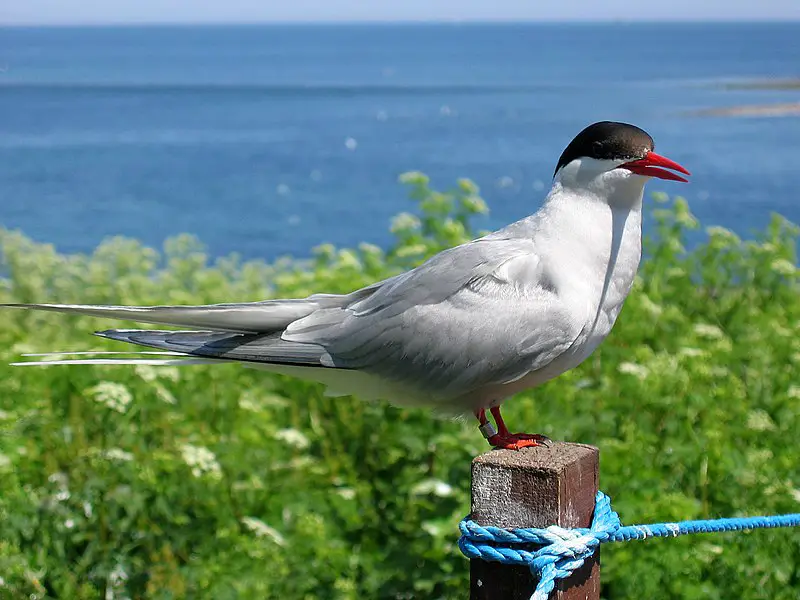
The Arctic tern is an incredible bird with remarkable migratory behavior.
It breeds in the northern regions of Europe, Asia and North America during summer before undertaking its migration along a convoluted route to reach the Antarctic for winter.
This species has adapted extremely well to its environment – it can fly long distances while navigating easily, thanks to its excellent eyesight.
Furthermore, they can survive in temperatures as low as -40 degrees Celsius.
The Arctic Tern is also known for being one of the longest-living birds on Earth; some have been recorded living up to 30 years old.
Scientific classification:
| Kingdom | Animalia |
| Phylum | Chordata |
| Class | Aves |
| Order | Charadriiformes |
| Family | Laridae |
| Genus | Sterna |
| Species | S. paradisaea |
Also Featured In: Shetland Islands Birds You Should Know, Tundra Birds
26. European Green Woodpecker
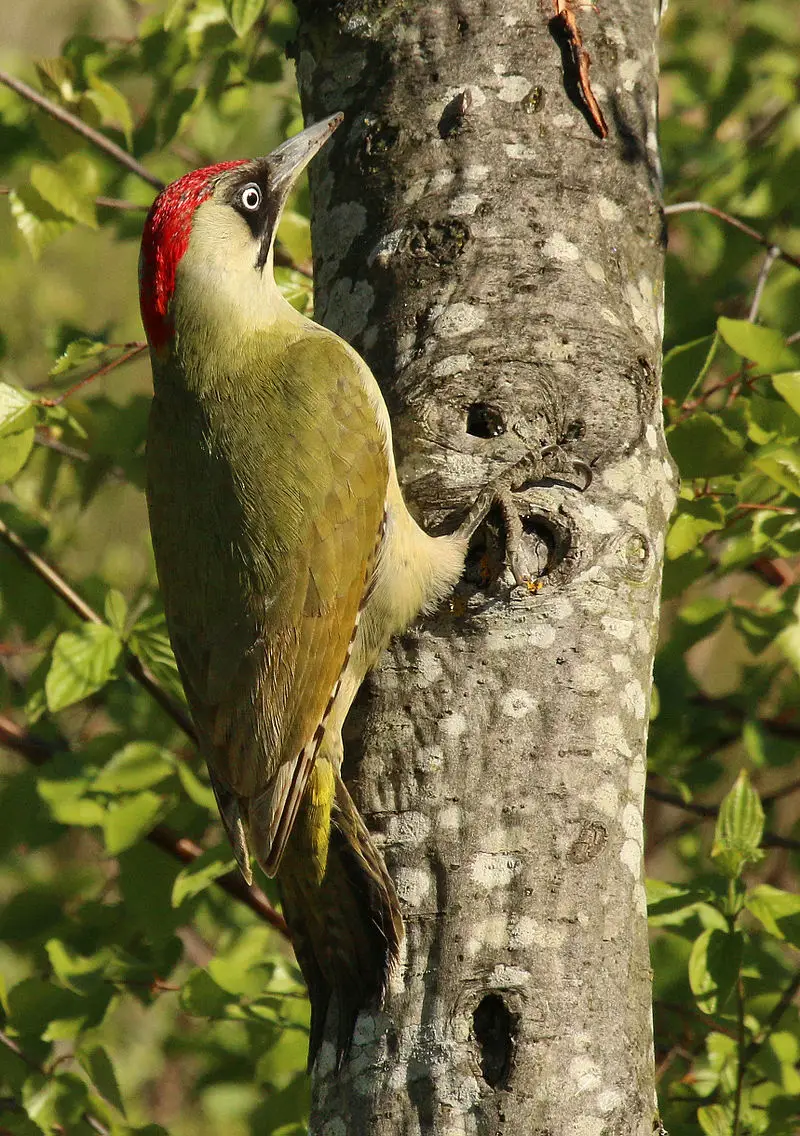
The European green woodpecker is a vibrant species with striking features. The body has an emerald hue, while males have a red crown and black moustache that extends to the middle of their forehead.
Females lack this characteristic feature but instead possess barred markings beneath the wings and yellow throats and cheeks.
It can be found in many parts of Europe and western Palearctic regions such as Spain and Portugal where it is replaced by its similar cousin; Iberian green woodpecker (Picus sharpei).
This bird loves inhabiting open forests or grasslands for its food source, which typically consists of insects like ants, beetles, and spiders.
Its powerful bill allows it to dig into tree bark, searching for larvae underneath, making it an efficient predator in these environments.
Scientific classification:
| Kingdom | Animalia |
| Phylum | Chordata |
| Class | Aves |
| Order | Piciformes |
| Family | Picidae |
| Genus | Picus |
| Species | P. viridis |
27. Parasitic Jaeger
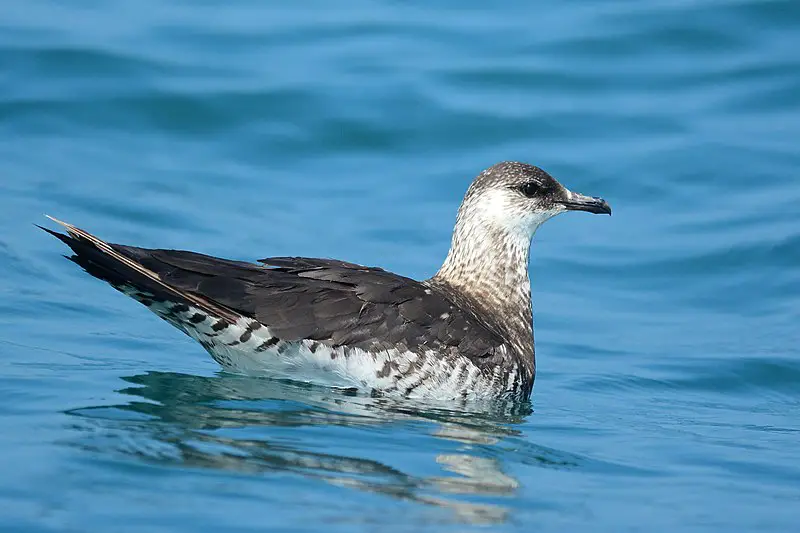
The Parasitic Jaeger is a migratory bird that breeds in cold climates of Northern Scandinavia, Scotland, Iceland, Greenland, and parts of Canada, Alaska, and Siberia.
During the breeding season, it feeds primarily on kleptoparasitism – stealing food from other birds.
In winter, they migrate to warmer regions across the southern hemisphere, where they feed mainly by scavenging off fish or carrion left behind by fishing boats or whales.
This species is easily identified by its brownish-gray plumage with white patches on its wings and tail feathers and yellow eyes, which are quite distinctive among skuas.
The parasitic jaeger has adapted to many habitats ranging from coastal areas to inland lakes, making them an interesting species to watch out for while exploring nature.
Scientific classification:
| Kingdom | Animalia |
| Phylum | Chordata |
| Class | Aves |
| Order | Charadriiformes |
| Family | Stercorariidae |
| Genus | Stercorarius |
| Species | S. parasiticus |
Also Featured In: Birds that Live in Svalbard, Birds that Live in Faroe Islands
28. Common Chiffchaff
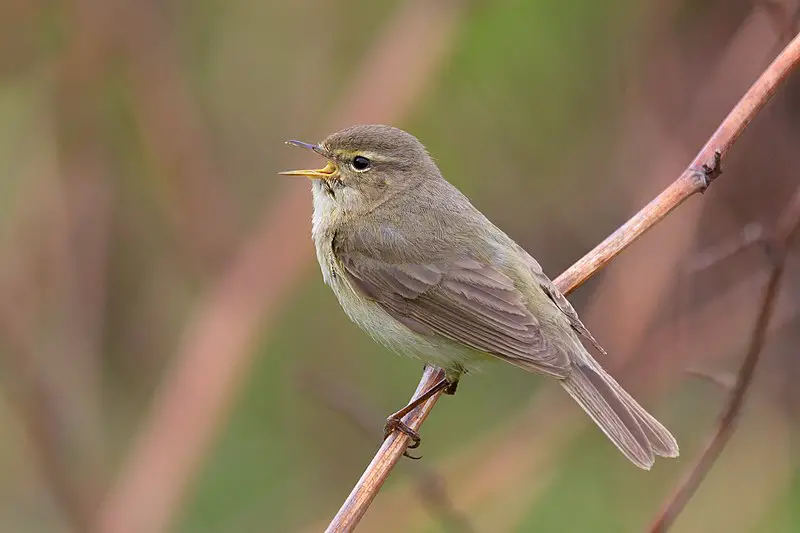
The Common Chiffchaff is a small bird found in northern and temperate Europe and the Palearctic.
It has greenish-brown plumage on its upper parts, off-white feathers beneath, and gets its name from an onomatopoeic call that resembles “chiff chaff”.
This migratory passerine breeds in open woodlands during summer before heading to southern Asia, western Europe, and North Africa for winter.
A frequent visitor at gardens with good insect supplies, it feeds mainly on insects such as flies, beetles, or ants, which are caught by gleaning foliage or hawking aerial prey.
Despite being one of Britain’s most common birds – estimated numbers between 6–9 million pairs – their population numbers have declined over recent years due to habitat destruction caused by climate change.
Scientific classification:
| Kingdom | Animalia |
| Phylum | Chordata |
| Class | Aves |
| Order | Passeriformes |
| Family | Phylloscopidae |
| Genus | Phylloscopus |
| Species | P. collybita |
Also Featured In: Gujarati Birds, Birds that can be Seen in October
29. Swallows
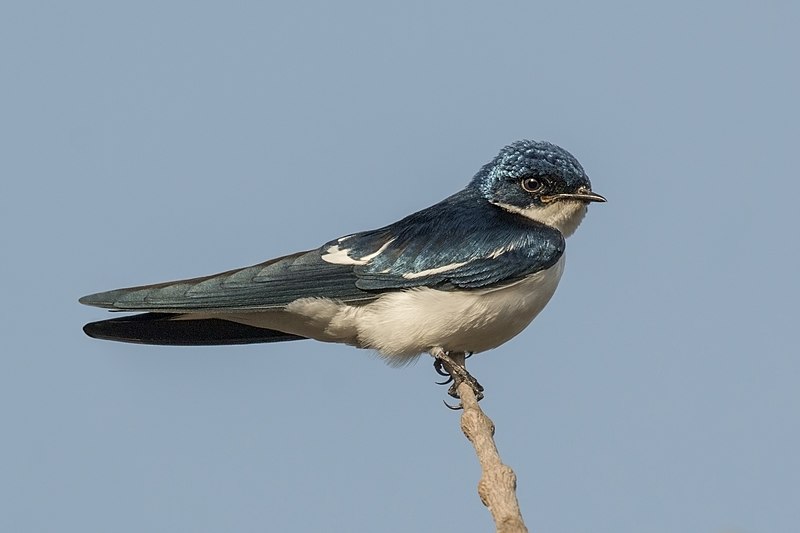
Swallows are small songbirds found worldwide on all continents, even Antarctica. They have a distinctive appearance and are highly adapted to aerial feeding with their long wings and forked tails.
There are an estimated 90 species of swallows in 19 different genera, making them one of the most widespread bird families on earth.
The barn swallow is perhaps the most well-known species among these birds due to its presence near human settlements across Europe; they’re so ubiquitous that “swallow” has become synonymous with this particular type of bird there.
Swallows also play important roles in ecology as insectivores, some species migrating vast distances yearly between summer breeding grounds and wintering locations.
Scientific classification:
| Kingdom | Animalia |
| Phylum | Chordata |
| Class | Aves |
| Order | Passeriformes |
| Suborder | Passeri |
| Family | Hirundinidae Rafinesque, 1815 |
Also Featured In: House Birds You’ll Love to Pet, Summer Birds that Live around Us
30. Eurasian Bullfinch
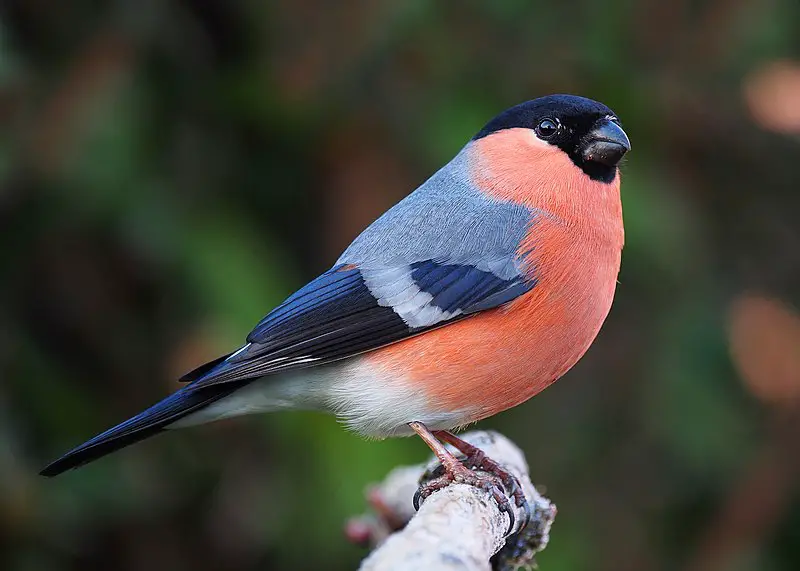
The Eurasian Bullfinch is a small bird in the finch family Fringillidae. It has an unmistakable appearance with its plump body and bright pink chest.
Its head is grayish-brown, while its wings are black with white edging along the tips of some feathers. The tail is also black-tipped with white or yellowish edges.
They inhabit open woodlands and gardens throughout Europe, North Africa, parts of Asia, and western Siberia in search of food such as berries, buds, or insects, which they feed on during winter when other sources become scarce.
These birds form monogamous pairs to breed each year between March through August, where both parents incubate their eggs until hatching around mid-May.
Usually, two broods are produced per season if conditions are favorable for nesting success.
Scientific classification:
| Kingdom | Animalia |
| Phylum | Chordata |
| Class | Aves |
| Order | Passeriformes |
| Family | Fringillidae |
| Subfamily | Carduelinae |
| Genus | Pyrrhula |
| Species | P. pyrrhula |
Also Featured In: Most Common Lithuanian Birds, Red European Birds
31. Tit
Tit birds are small passerine birds belonging to the family Paridae, found mainly in Northern Hemisphere and Africa.
These active little birds can be seen singing sweet songs throughout the day or scavenging for food at feeders.
They use short, stout bills to crack open seeds and nuts easily. Tit species range from chickadees to titmice; all of them sport a distinctive black head cap that stands out against their pale grey bodies.
Their bright eyes allow them excellent vision while searching for food – even on gloomy days when other predators may not see as well.
Tits are an important part of any healthy ecosystem and provide many ecological services, such as insect control and seed dispersal.
Scientific classification:
| Kingdom | Animalia |
| Phylum | Chordata |
| Class | Aves |
| Order | Passeriformes |
| Infraorder | Passerida |
| Family | Paridae Vigors, 1825 |
Also Featured In: Willows Birds Around You, Flocks Birds around Us
32. Lesser Spotted Woodpecker
The Lesser Spotted Woodpecker (Dryobates minor) is a small, attractive bird from the woodpecker family Picidae.
It is found in much of Europe and parts of Asia.
The species was previously classified under the genus Dendrocopos but has now been reassigned to Dryobates.
This beautiful little bird is characterized by its brown body with black wings, tail, and head.
Its belly and throat are white, while red patches are on both sides of its neck-collar region. In addition, it also possesses yellowish stripes near its eyes that make it look quite smart.
The lesser spotted woodpeckers feed mainly on insects such as ants and beetles, which they find beneath tree bark or among dead leaves.
They can be seen foraging alone or in pairs since they prefer living an isolated life away from human settlements.
Thus, if you ever wish to spot one, remember not to disturb them during their food search, or else you might miss out on this amazing opportunity.
Scientific classification:
| Kingdom | Animalia |
| Phylum | Chordata |
| Class | Aves |
| Order | Piciformes |
| Family | Picidae |
| Genus | Dryobates |
| Species | D. minor |
33. Black Redstart
The black redstart is a small passerine bird found in the genus Phoenicurus. It was previously classified as part of the thrush family but now belongs to the Old World flycatcher family.
It has an overall black coloration with striking patches of bright orange or rusty-red on its wings and tail, giving it its name “black redstart”.
The male also sports a prominent crest, which he can raise when displaying for females during the breeding season.
This species inhabits open woodland areas and generally feeds on insects such as flies, beetles, spiders, and caterpillars, although they will supplement their diet with berries where available.
They are often seen perched very prominently from exposed branches near food sources like hedgerows or tree stumps, making them easier to spot than some other birds of similar size
Scientific classification:
| Kingdom | Animalia |
| Phylum | Chordata |
| Class | Aves |
| Order | Passeriformes |
| Family | Muscicapidae |
| Genus | Phoenicurus |
| Species | P. ochruros |
Also Featured In: Common Cornwall Birds, Fuerteventura Island Birds You Need to See
34. Balearic Shearwater
The Balearic shearwater is a medium-sized bird in the Procellariidae family, also known as puffins. It’s named after Mauretania, an old name for North Africa.
These birds can be found around islands and coasts of western Europe and northwest Africa.
They have long wings that help them to fly over vast distances during migration season from their breeding grounds to wintering areas farther south.
Their diet consists mainly of small fish they catch by diving into the sea with great agility or plucking out of shallow waters while swimming on the surface.
When not mating or raising chicks, these birds live solitary lives at sea but gather together when feeding or roosting on land near coastal cliffsides and beaches, where they nest in burrows underground lined with vegetation debris and feathers
Scientific classification:
| Kingdom | Animalia |
| Phylum | Chordata |
| Class | Aves |
| Order | Procellariiformes |
| Family | Procellariidae |
| Genus | Puffinus |
| Species | P. mauretanicus |
Also Featured In: Most Common Spain Birds, Most Popular Birds in Mallorca
35. Black Guillemot
The Black Guillemot is a striking seabird throughout the northern Atlantic and eastern North American coasts. It has black feathers, white underparts, a red bill, and bright yellow feet.
They live in single or small groups around rocky shores, cliffs, and islands.
During winter months, they migrate southwards from their high arctic breeding grounds to search for food sources such as fish eggs or invertebrates like shrimp that can be caught near shorelines.
Their diet also includes seeds and berries during summertime while nesting on coastal ledges, creating burrows where they lay up to four pastel-colored eggs at once.
These amazing birds are very efficient swimmers, using their wings and webbed feet to propel themselves through water quickly while hunting prey.
Scientific classification:
| Kingdom | Animalia |
| Phylum | Chordata |
| Class | Aves |
| Order | Charadriiformes |
| Family | Alcidae |
| Genus | Cepphus |
| Species | C. grylle |
Also Featured In: Birds You’ll Find in the Sea, Acadia National Park Birds
36. Red Kite
The Red Kite is a magnificent bird of prey belonging to the family Accipitridae. It can be found in western Europe and northwest Africa, where it breeds, while occasionally occurring in northern Iran.
These birds are medium-large with wingspans ranging from 125 cm to 170 cm wide. They have reddish brown plumage on their upperparts and pale gray underneath.
The Red Kite feeds mainly on small mammals, carrion, and insects, which they hunt for by soaring through the air using thermals to gain altitude before diving onto its prey.
Furthermore, this species has adapted well to human presence since it often scavenges near roadsides or rubbish dumps as an easy food source.
These majestic creatures make up a beautiful part of our natural environment that should not go unnoticed.
Scientific classification:
| Kingdom | Animalia |
| Phylum | Chordata |
| Class | Aves |
| Order | Accipitriformes |
| Family | Accipitridae |
| Genus | Milvus |
| Species | M. milvus |
37. Western Jackdaw

The European robin is a small passerine bird native to Europe, North Africa, and western Asia. It has an orange-red breast and face with grey upperparts.
Its distinctive red coloring makes it one of Europe’s most popular garden birds. Robins can live throughout much of Eurasia in woods, hedgerows, parks, gardens, and scrubland habitats such as heaths or moorlands.
They feed mainly on insects but also eat worms, fruit flies, and other invertebrates they find while foraging around woodland floor vegetation or perching from low branches to catch their prey in flight.
They are highly territorial during the breeding season, which runs from March through August when both males & females stand guard over their territories using song communication to mark boundaries between each others’ turf.
38. Eurasian Sparrowhawk
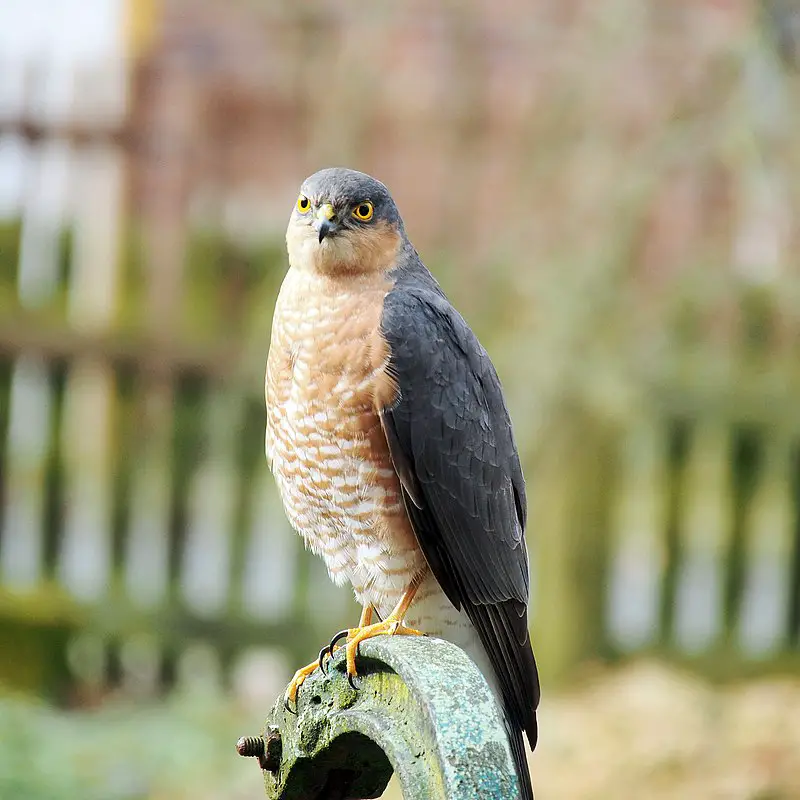
The Eurasian sparrowhawk is a small bird of prey from the Accipitridae family. It has distinct blue-grey upperparts and orange barred underparts, while females and juveniles appear brown with brown barring underneath.
The females of this species can grow up to 25% larger than males, which makes it one of the largest size differences among birds of its kind.
They are found all over Europe, Asia, and North Africa, where they hunt for quarries such as mammals, lizards, or even smaller birds, using their powerful talons to catch them from aerial dives.
They have adapted well to human presence by nesting on buildings or urban parks due to a lack of natural habitats, making them interesting creatures for wildlife observation across cities, too.
Scientific classification:
| Kingdom | Animalia |
| Phylum | Chordata |
| Class | Aves |
| Order | Accipitriformes |
| Family | Accipitridae |
| Genus | Accipiter |
| Species | A. nisus |
Also Featured In: Moscow Birds You Need to See, Common Carnivore Birds
39. Osprey
The Osprey is a majestic bird of prey with an incredibly wide habitat range. It has distinctive brown upperparts, greyish head, and underparts, making it easily identifiable in the skies above many regions worldwide.
With a wingspan of up to 180cm (71in) and a body length reaching 60cm (24in), this large raptor specializes in hunting for fish, soaring high over rivers and coasts, and searching for its next meal.
Despite living near water sources, they can also be found inhabiting mountainsides or even woodlands, proving their incredible adaptability. It is an impressive species that truly deserves admiration.
Scientific classification:
| Kingdom | Animalia |
| Phylum | Chordata |
| Class | Aves |
| Order | Accipitriformes |
| Family | Pandionidae |
| Genus | Pandion |
| Species | P. haliaetus |
40. Northern Goshawk
The Northern Goshawk is a medium-large bird of prey belonging to the Accipitridae family. It has been known as one of the true hawks, with “Accipiter” meaning hawk in Latin and “gentiles” referring to its noble characteristics.
They are found worldwide, most commonly in wooded areas such as forests or thickets, where they hunt small birds and mammals.
The males have spotted grey upperparts, while females tend to be fully brown above with some lighter barring on their underparts.
These raptors rely heavily on speed and agility when hunting from either perches or during aerial dives at high speeds for their prey, making them formidable predators that can reach up to 40 mph.
Scientific classification:
| Kingdom | Animalia |
| Phylum | Chordata |
| Class | Aves |
| Order | Accipitriformes |
| Family | Accipitridae |
| Genus | Accipiter |
| Species | A. gentilis |
41. Song Thrush
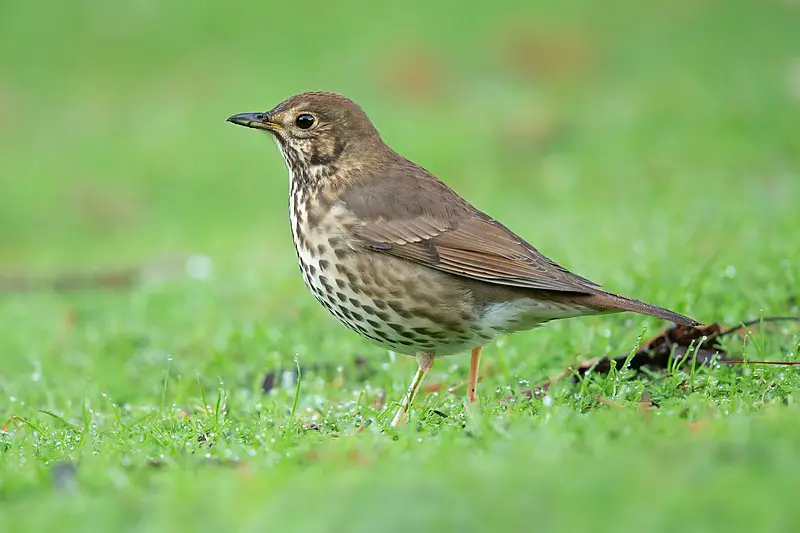
The Song Thrush is a beautiful bird that breeds across the West Palearctic. It has brown upper parts and creamy or buff underparts with black spots and three recognized subspecies.
Its vocalizations are particularly melodious; its song consists of repeated musical phrases, hence why it has been referenced often in poetry.
This species can be found breeding in forests, gardens, and parks during summertime before migrating elsewhere for winter.
With its attractive plumage and lovely singing voice, it’s no wonder this thrush is so beloved by many.
Scientific classification:
| Kingdom | Animalia |
| Phylum | Chordata |
| Class | Aves |
| Order | Passeriformes |
| Family | Turdidae |
| Genus | Turdus |
| Species | T. philomelos |
Also Featured In: Black Birds in New Zealand,
42. Common Buzzard
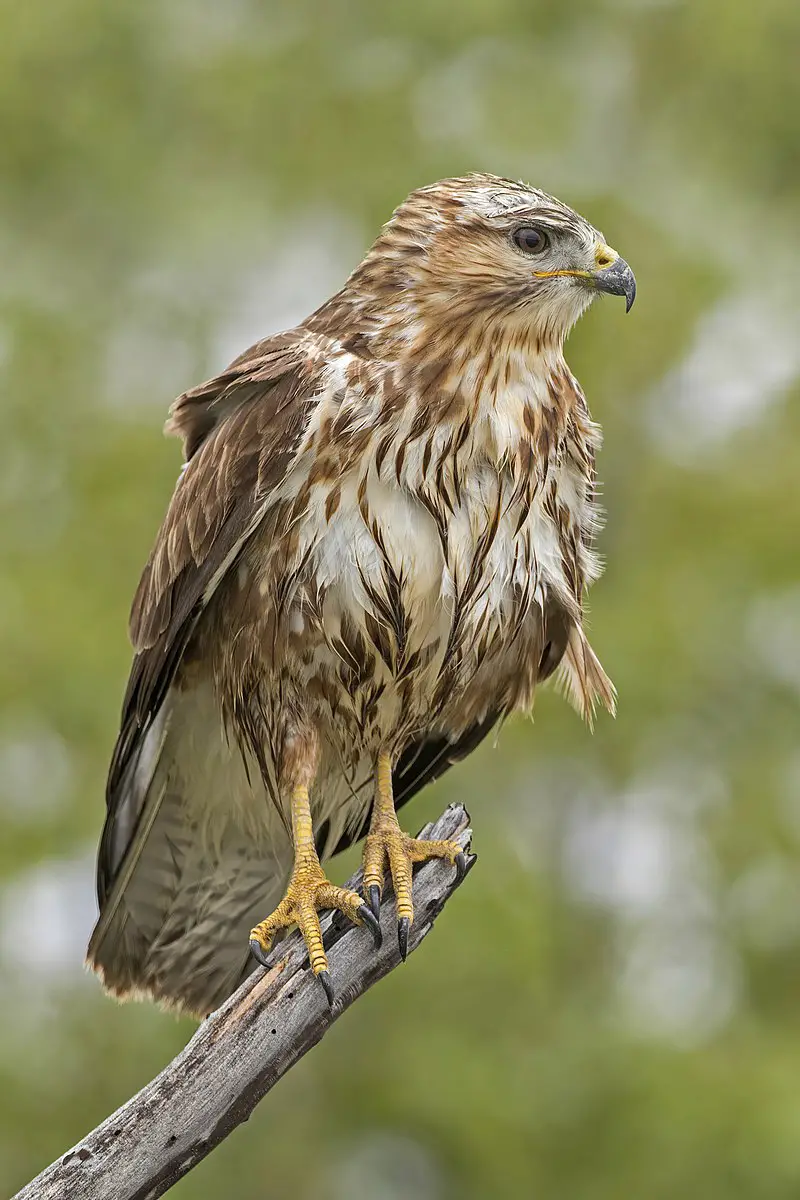
The common buzzard is a large bird of prey across much of Europe, the Palearctic region, and parts of Asia. This species has medium to dark brown plumage with lighter streaks on its body.
It has broad wings, useful for soaring high in search of food, such as small rodents, lizards, amphibians, and insects.
Buzzards often hunt from a perch or while hovering above open areas like fields and meadows where they can easily spot their prey below.
They also use thermals rising from warm ground during hot summer days to gain altitude without expending energy flapping their wings.
In addition to hunting alone, these birds will sometimes join forces with others when scavenging carrion or chasing away predators that threaten their nests full of eggs or young chicks
Scientific classification:
| Kingdom | Animalia |
| Phylum | Chordata |
| Class | Aves |
| Order | Accipitriformes |
| Family | Accipitridae |
| Genus | Buteo |
| Species | B. buteo |
Also Featured In: Asian Birds, Birds of Wales: Exploring Diverse Habitats and Conservation Efforts
43. Golden Eagle
The Golden Eagle is an iconic bird of prey found throughout the northern hemisphere. It is a large, powerful raptor with dark brown feathers and lighter golden-brown plumage on its nape.
Immature eagles have white patches around their beaks, tails, and wings, which they lose as they mature.
Its diet consists mostly of small mammals such as rabbits, hares, and marmots but can also include birds or reptiles, depending on where it lives.
These majestic creatures are known for their remarkable strength in flight, using thermal updrafts to soar high into the sky, searching for food, or simply enjoying the view below them.
They are often seen soaring alone over open expanses, looking out for potential threats from other predators like wolves or foxes that may encroach upon their territory.
Scientific classification:
| Kingdom | Animalia |
| Phylum | Chordata |
| Class | Aves |
| Order | Accipitriformes |
| Family | Accipitridae |
| Genus | Aquila |
| Species | A. chrysaetos |
44. Barn Owl
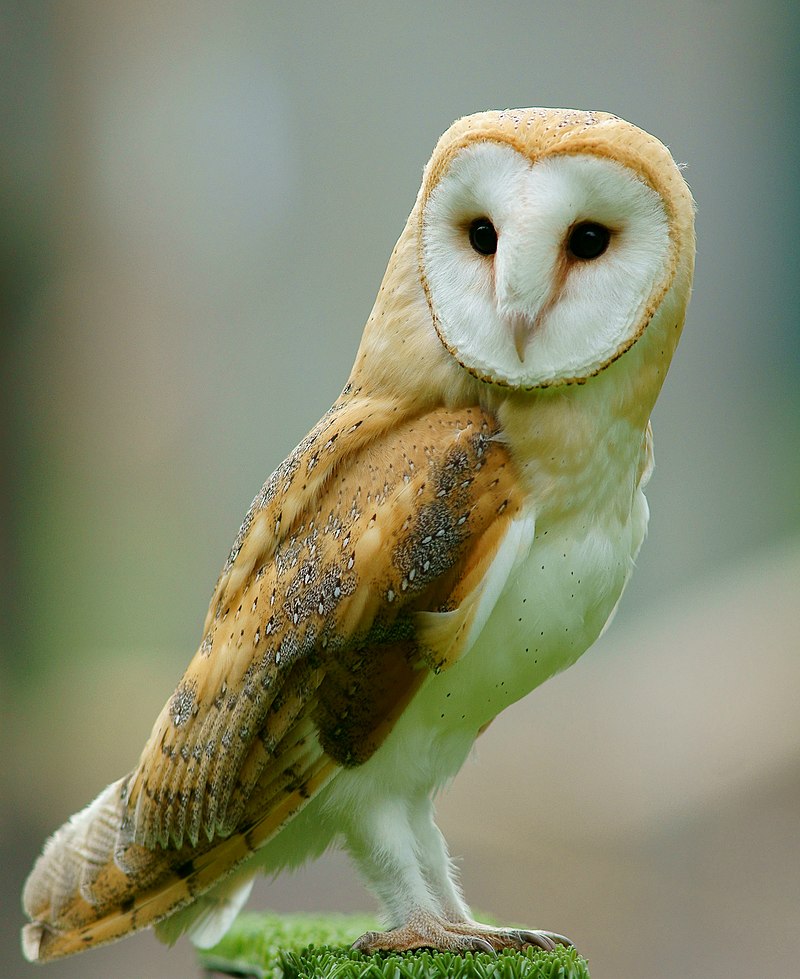
Barn owls are a beautiful and fascinating species of birds found around the world, except in polar and desert regions, most of Indonesia, and some Pacific Islands.
They have large eyes, thin legs, and long wings that help them to hunt silently in low-light conditions.
Their white coloring helps them blend into their surroundings, making it easier for them to catch prey.
Barn owls are nocturnal hunters using their impressive hearing capabilities to locate rodents moving within vegetation or underground tunnels.
They also feed on insects such as beetles, moths, etc., which they can detect from high up in flight using their excellent vision even at night.
The barn owl plays an important role in balancing ecosystems by controlling rodent populations, so they should be protected wherever possible so that this vital service continues uninterruptedly.
Scientific classification:
| Kingdom | Animalia |
| Phylum | Chordata |
| Class | Aves |
| Order | Strigiformes |
| Family | Tytonidae |
| Genus | Tyto |
| Species | T. alba |
45. Eurasian Teal
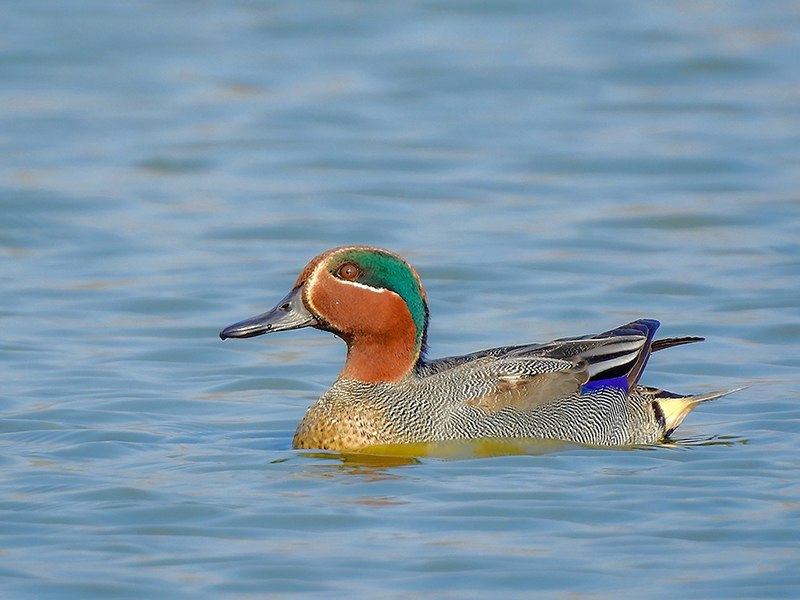
The Eurasian teal, also known as the common teal or the Eurasian green-winged teal, is a small dabbling duck that inhabits temperate Europe and Asia.
It has an unmistakable blue-green color, which gives it its name.
During winter, they migrate south in large flocks to areas with warmer climates where more food is available for them to feed on.
The Eurasian Teals are highly social birds; they often congregate in groups of hundreds or even thousands during migration periods.
They mostly feed on aquatic vegetation such as grasses and weeds but will occasionally hunt insects, too.
These ducks make beautiful sights when flying over lakes or streams, their wings producing a distinctive whistling sound while they glide across the sky.
Scientific classification:
| Kingdom | Animalia |
| Phylum | Chordata |
| Class | Aves |
| Order | Anseriformes |
| Family | Anatidae |
| Genus | Anas |
| Species | A. crecca |
Also Featured In: Water Birds Live around Us, Most Common Lake Birds
46. Common Starling

The Common Starling is a medium-sized passerine bird that belongs to the Starling family. It has glossy black plumage with a metallic sheen; at certain times of the year, it can be speckled with white.
The bill and legs are typically pink or black depending on the season, while its length measures about 8 inches long.
Its diet consists mainly of insects but includes small fruits, seeds, and human food waste.
They live in large flocks, which protects predators, although they can become quite aggressive when defending their nesting sites during breeding seasons.
Overall, this species is highly adaptable and widely distributed across many parts of Europe, making them one of the most successful birds in the region today.
Scientific classification:
| Kingdom | Animalia |
| Phylum | Chordata |
| Class | Aves |
| Order | Passeriformes |
| Family | Sturnidae |
| Genus | Sturnus |
| Species | S. vulgaris |
47. Peregrine Falcon
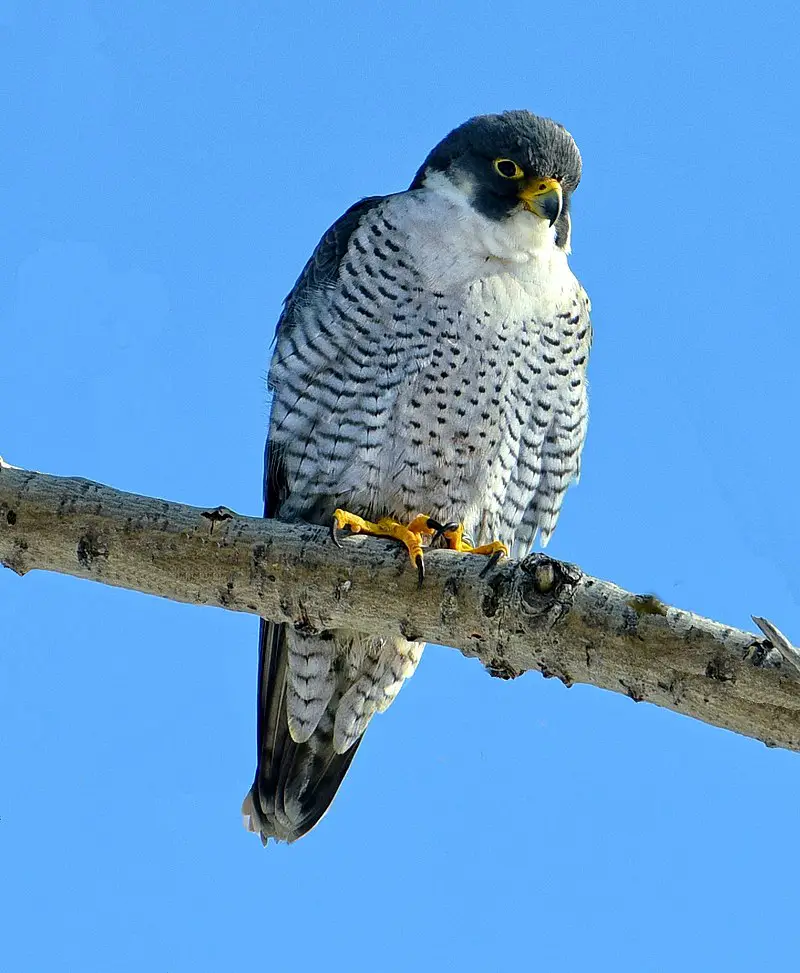
The Peregrine Falcon is a majestic bird of prey belonging to the family Falconidae. It has a blue-grey back, barred white underparts, and a black head, making it easily recognizable.
This intelligent raptor is known for its incredible speed, reaching over 320 km/h (200 mph) during hunting dives. It is one of the fastest animals.
The peregrine falcon can be found worldwide, from Arctic tundra to tropical rainforests, thriving with humans or in high alpine mountains far from civilization.
Their beauty, power, and adaptability make them an impressive species that have earned respect among many cultures throughout history as symbols of strength and endurance.
Scientific classification:
| Kingdom | Animalia |
| Phylum | Chordata |
| Class | Aves |
| Order | Falconiformes |
| Family | Falconidae |
| Genus | Falco |
| Species | F. peregrinus |
48. Eurasian Jay
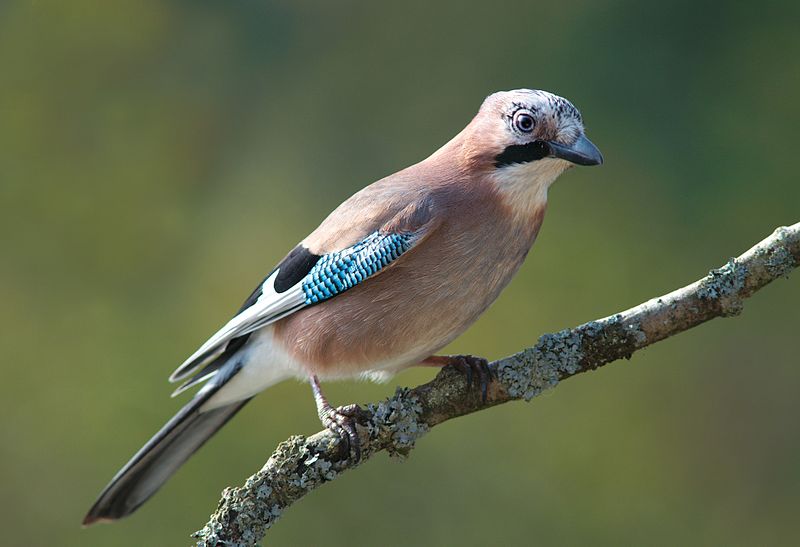
The Eurasian jay is a beautiful passerine bird of the crow family, Corvidae. It has bright pinkish-brown plumage with a white throat and two black stripes on each side.
The upper wings have an eye-catching blue panel, while its tail is all black. This species mainly resides in woodlands, spanning vast regions from western Europe to India and north-west Africa.
Its diet consists of small invertebrates like insects and fruits, seeds, and nuts, making it quite adaptable to food sources.
With its loud calls echoing through the forests it inhabits, this amazing creature will make your day brighter if you ever get the chance to spot one.
Scientific classification:
| Kingdom | Animalia |
| Phylum | Chordata |
| Class | Aves |
| Order | Passeriformes |
| Family | Corvidae |
| Genus | Garrulus |
| Species | G. glandarius |
Also Featured In: Common Estonian Birds,
49. White-Tailed Eagle
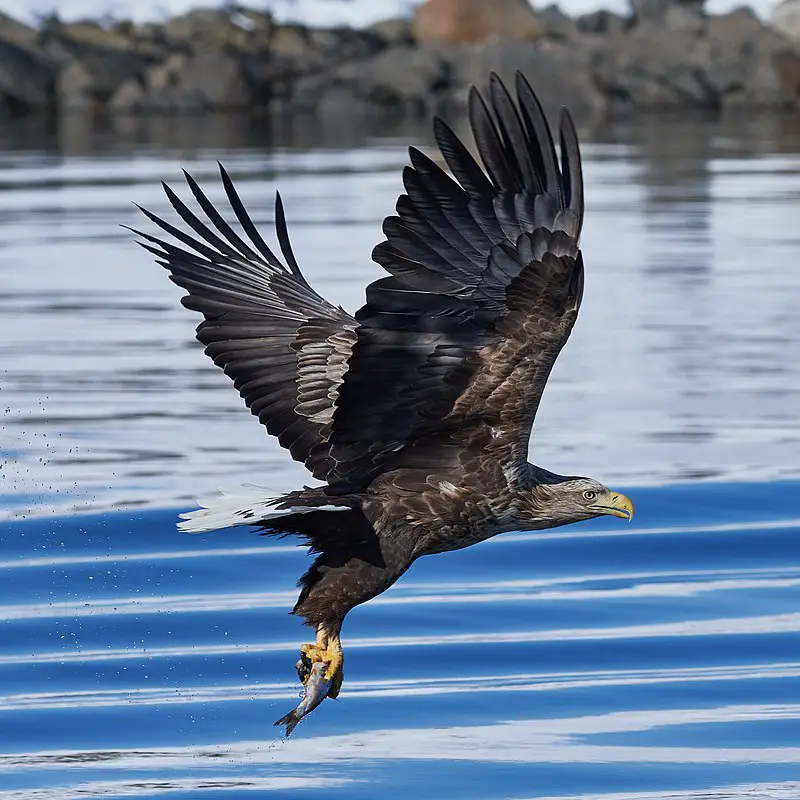
The white-tailed eagle is an impressive species of sea eagle found across temperate Eurasia. This majestic bird belongs to the family Accipitridae, which includes hawks, kites, and harriers.
It has a wingspan of up to 2.5 meters and can weigh 4 kilograms or more.
The plumage varies in color from dark brown above with a paler head and neck while its tail is pure white – hence its name.
They feed mainly on fish but take small mammals, birds, and carrion when available.
White-tailed eagles are solitary by nature but form pairs during nesting season, typically near bodies of water such as lakes or coasts, where they build large stick nests on trees or cliffsides for their young ones to hatch safely in peace.
Scientific classification:
| Kingdom | Animalia |
| Phylum | Chordata |
| Class | Aves |
| Order | Accipitriformes |
| Family | Accipitridae |
| Genus | Haliaeetus |
| Species | H. albicilla |
Also Featured In: Belarus Birds You Should Know, Birds You’ll Find in Hokkaido
50. Shrike
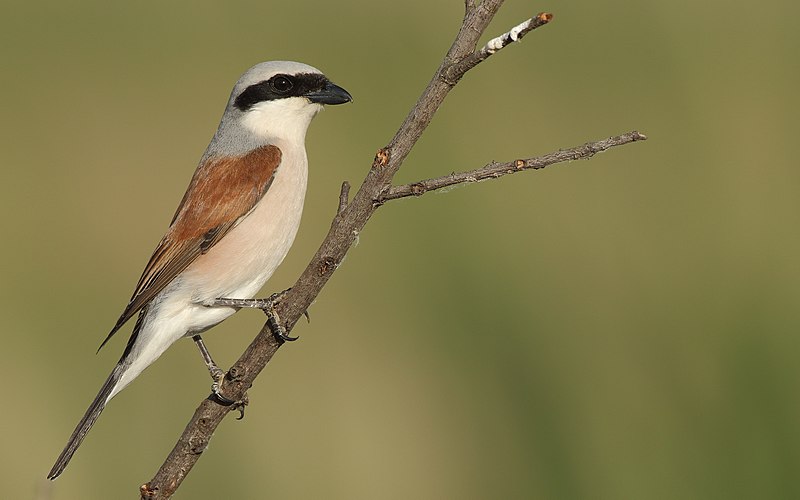
Shrikes are small passerine birds of the family Laniidae, with 34 species in four genera. They get their name from the Old English word “scrīc,” which refers to their shriek-like call.
These birds have earned the nickname ‘butcherbirds’ due to their feeding habits; they impale prey on thorns or barbed wire fences for later consumption.
Shrikes also tend to be aggressive predators and hunt many animals, such as insects, small reptiles, rodents, and even smaller bird species.
In terms of physical appearance, these songbirds can vary greatly depending on the specific genus. They usually boast a large hooked bill atop an impressive crest and bright colors like gray, black, or brownish hues across their feathers.
It’s clear Shrike is quite a remarkable creature that has gained notoriety for both hunting prowess and distinctive vocalizations.
Scientific classification:
| Kingdom | Animalia |
| Phylum | Chordata |
| Class | Aves |
| Order | Passeriformes |
| Superfamily | Corvoidea |
| Family | Laniidae Rafinesque, 1815 |
51. Eurasian Hobby
The Eurasian hobby, or simply Hobby, is a small and slim falcon belonging to the Hypotriorchis subgenus. Swedish naturalist Carl Linnaeus first formally described the species in 1758 as Falco subbuteo.
It has long, pointed wings and tail, allowing it to perform acrobatic maneuvers when hunting for prey, such as dragonflies, swallows, and swifts in flight.
Its habitat includes open woodland areas with tall trees suitable for nesting, where it can be seen gliding gracefully on its silent wings during the summer months of northern Europe.
This shy bird of prey is an amazing sight due to its agility and speed, a true symbol of majesty in nature.
Scientific classification:
| Kingdom | Animalia |
| Phylum | Chordata |
| Class | Aves |
| Order | Falconiformes |
| Family | Falconidae |
| Genus | Falco |
| Species | F. subbuteo |
Conclusion
The diverse avian species inhabiting the United Kingdom, numbering at least 51, represent a rich tapestry of wildlife. These birds, from common garden visitors to rare migrants, contribute to the nation’s ecological balance and cultural heritage.
However, they face habitat loss, climate change, and pollution, necessitating concerted conservation efforts.
Through education, habitat preservation, and sustainable practices, we can ensure these feathered inhabitants’ continued presence and flourishing.
By appreciating and safeguarding our avian companions, we protect biodiversity and enrich our connection with nature for generations to come.